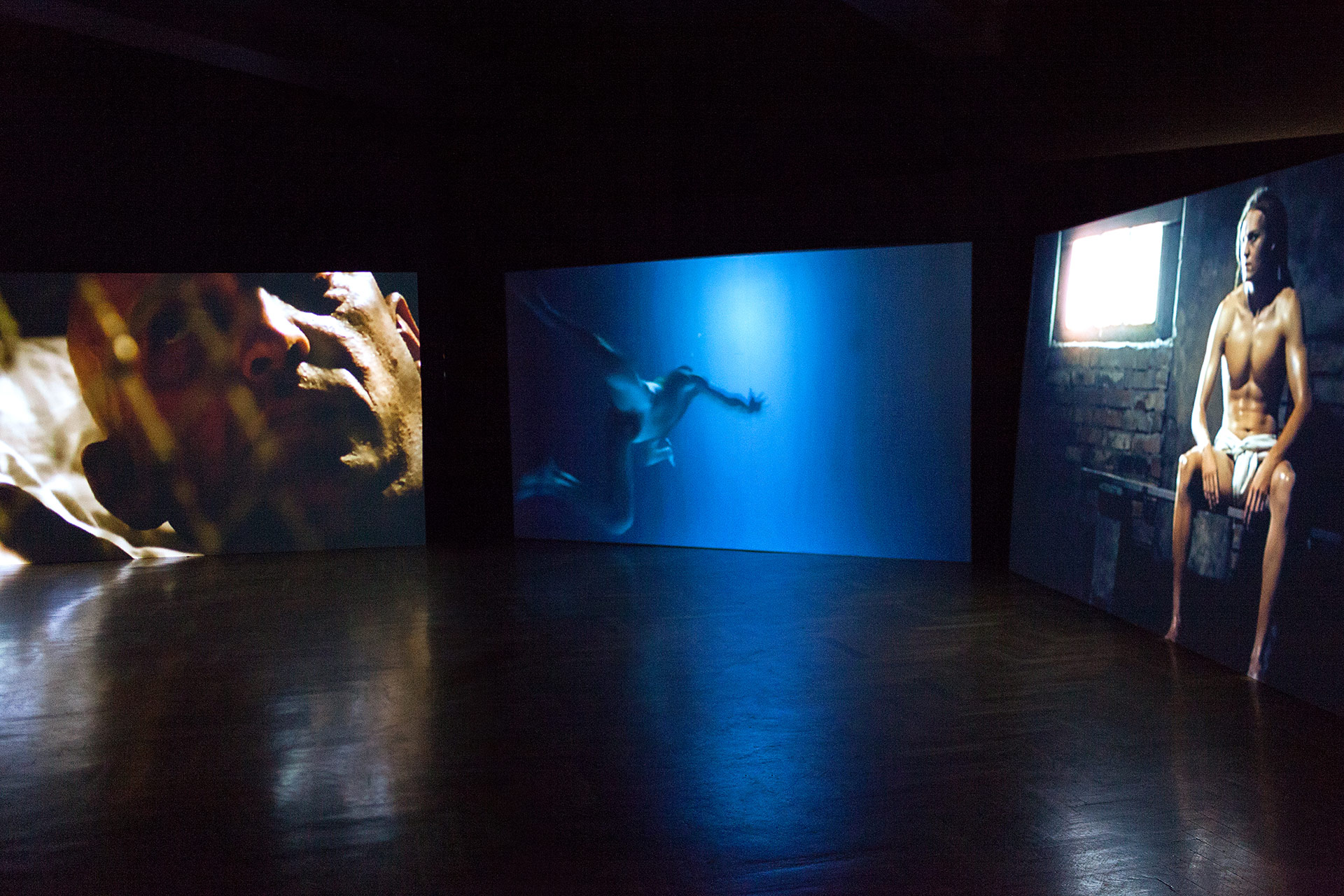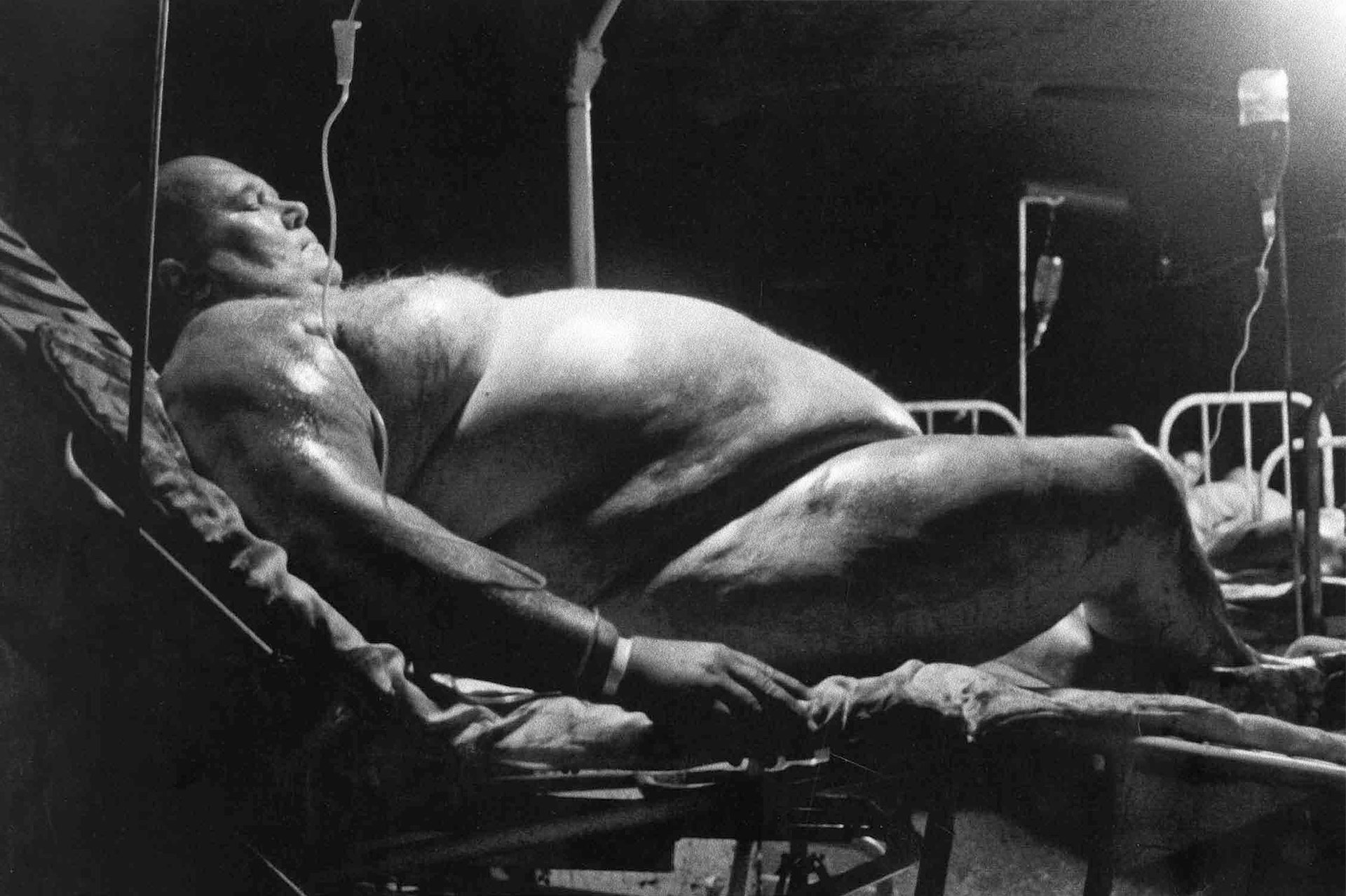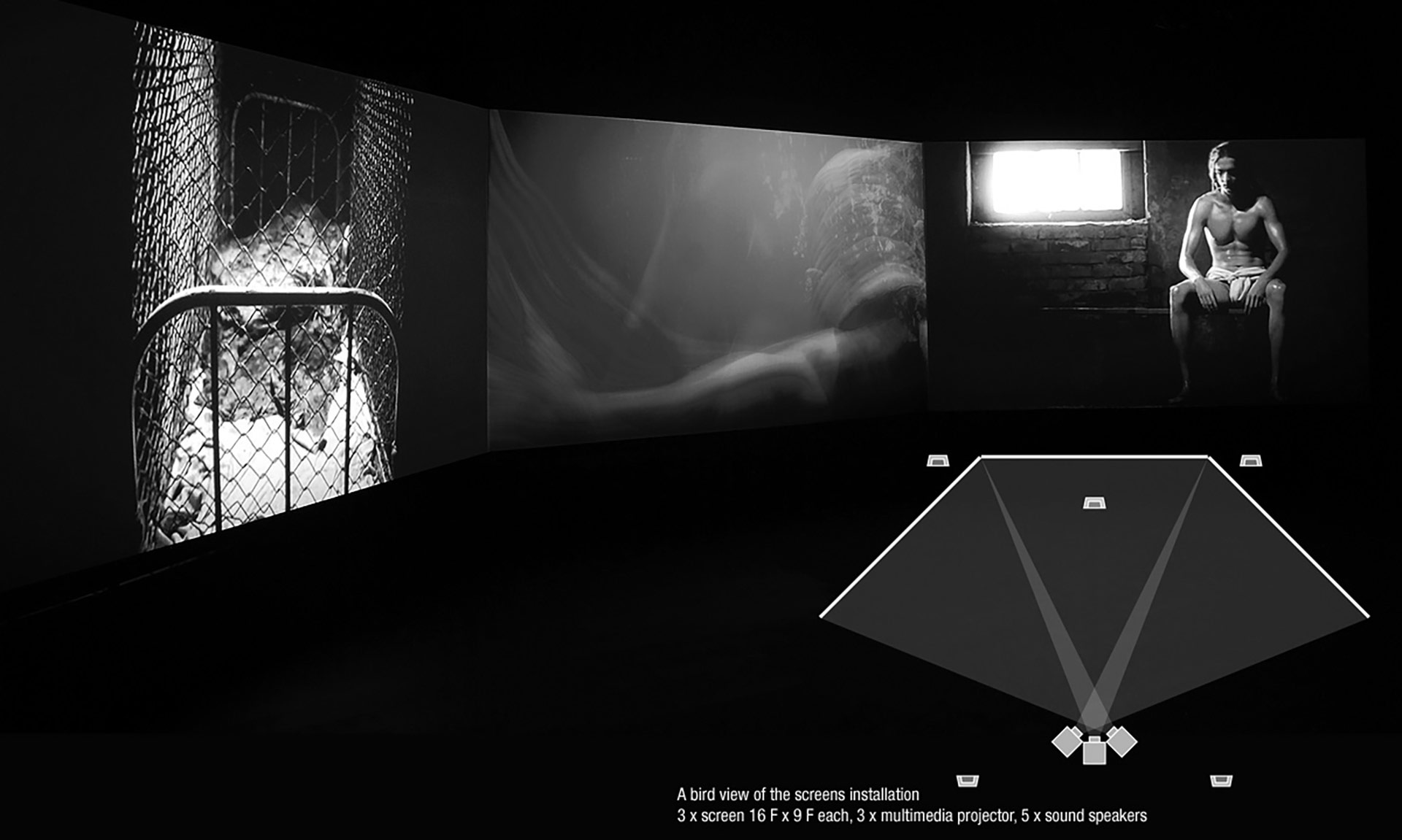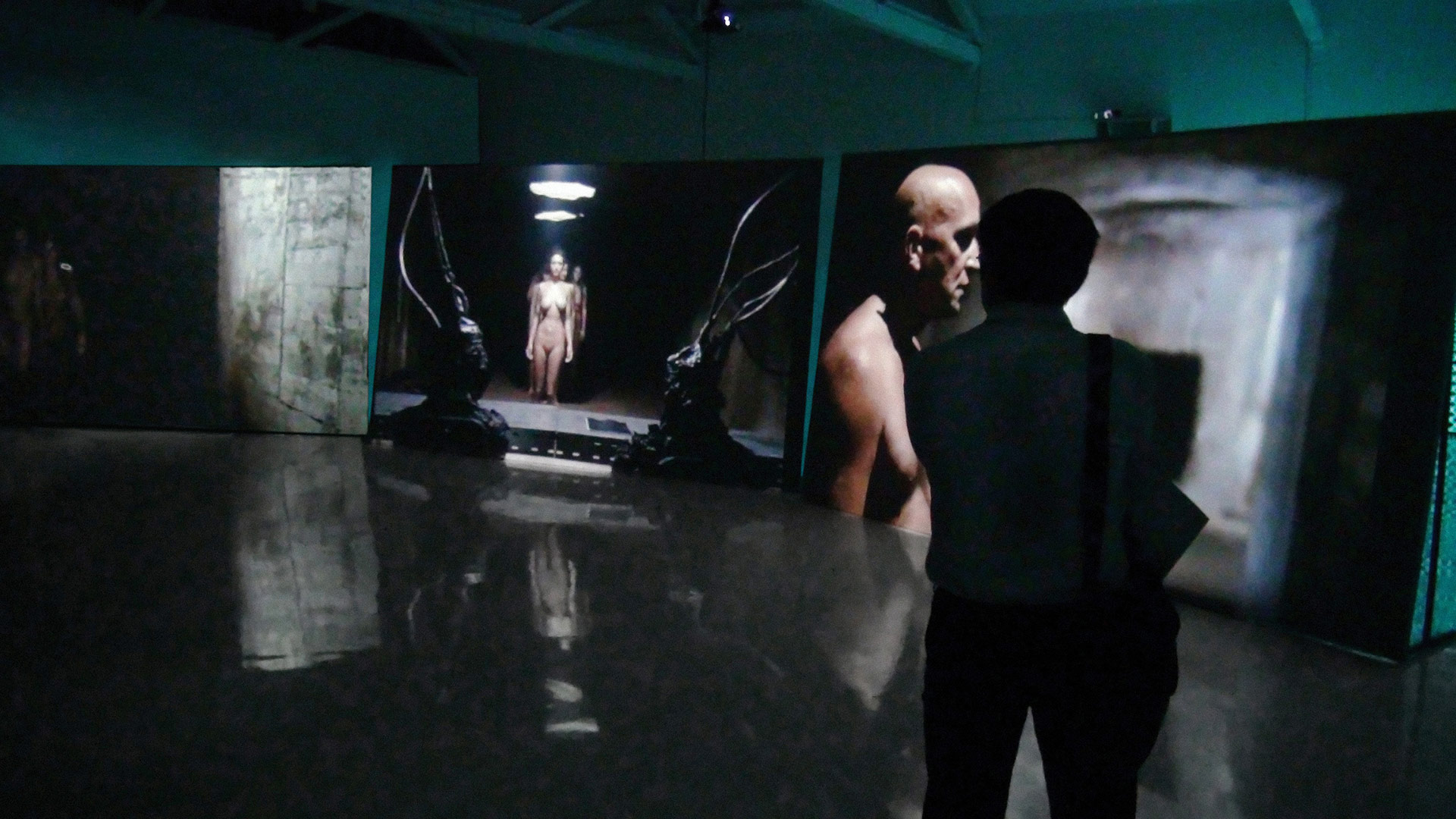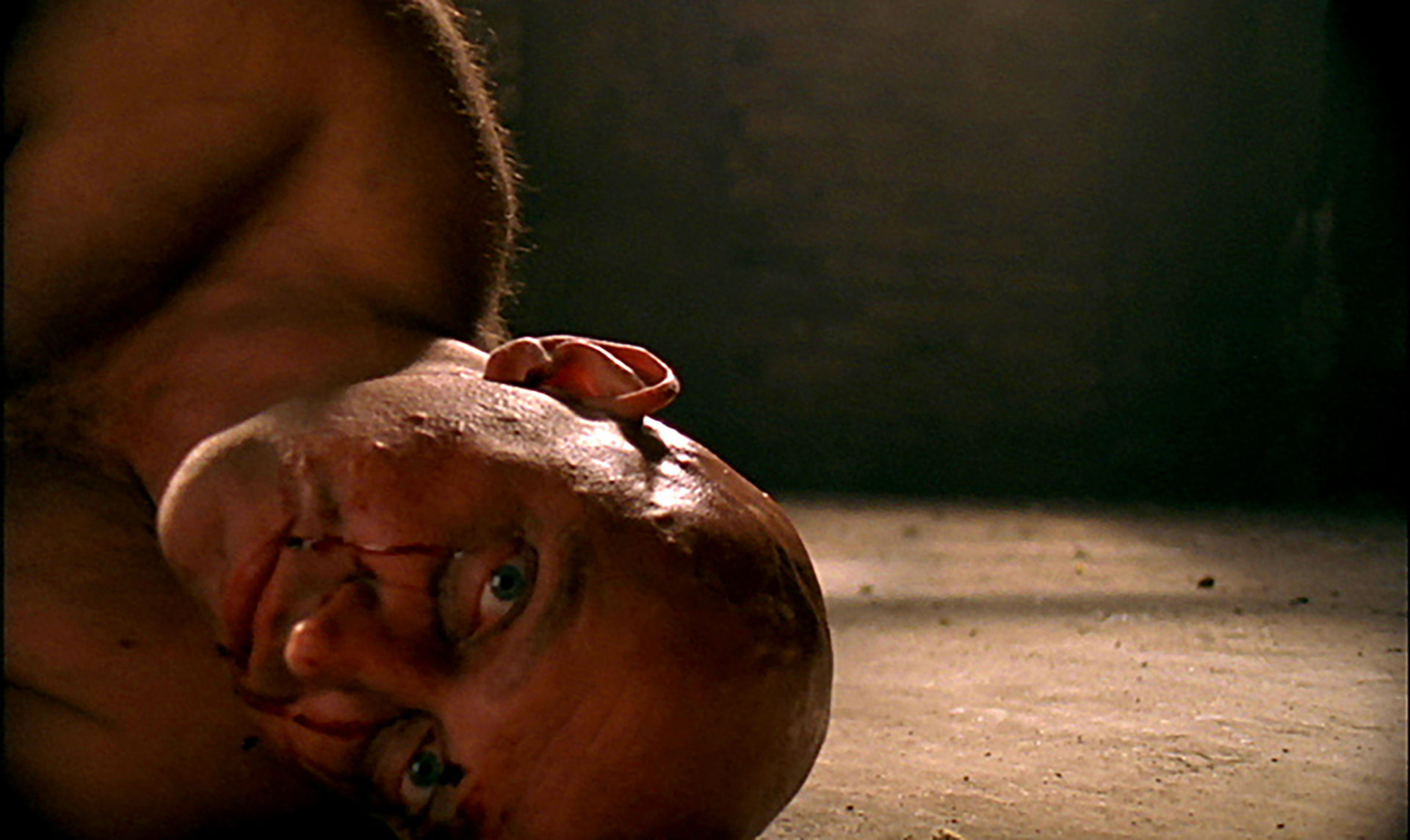Three channels and three screens is not a formal measure. One screen guarantees that what is seen on it could have happened; the second one that it might have happened that way; the third one – perhaps. All of them show that maybe it is only one version in an indefinite number of possibilities. The respon- sibility to work out what is being played rests on the viewers.
This is an infinite one-way journey. One thing in many dimensions and a few possibilities, out of which each is good, authentic. If one version is not giving us certainty, the other ver- sions give us the possibility to once more look through our rooted expec- tations towards our reality. At first glance, the narration is devoid of logic, but it includes a series of essential details and events. Complexity and senselessness is supposed to give us the impression that we are entangled in a schizophrenic, horrific delirium where there are no rules or logic. When we get to the limits of separation, we are at the threshold of disintegration, and a reflex tranquility appears – we can start all over again. The observer and the observed object are playing in the same show in which the object adjusts to the subject’s expectations, cause and effect can appear in free order (quantum world mechanics).
The main hero is the labyrinth – Riese (The Giant) complex. This is what the mining-construction project of Hitler’s Germany was called, which was started and never completed in the Owl Mountains (1943–1945). The works were done by the prisoners located in the nearby camps, mainly Gross-Rosen. It was very hard, crippling work. Even before the German army retreated, many prisoners were murdered to erase the traces and remove witnesses.
David Thomas talks with Wojtek Ulrich about the video-installation SCUM
DT: 3 SCREENS…VIDEO INSTALLATION…ARE YOU SURE THAT 35MM MATCHES THE CONTENT OF IT ALL?
WU: If I filmed in a direct, melodramatic and passionate manner, seemingly matching its content, it would be too stifling….and this has to be stifling, but in a different manner; this is what camera 35mm and a super 16mm give. I became convinced of it later, but intuitively felt that a 35mm is the best choice. It encodes the signal which the viewer will be able to decode. That which actually enters into the conflict with the content.
DT: Is it the content that demands such approach…?
WU: It was also to be an opposition to this unbearable style or suffocating “unstyle”, that we watch everywhere and which almost everybody uses all the time. “Video esthetics”, which was or became a-esthetics, or is or was indifferent to any “esthetic quality”, was brought to the “canon” from which one had to resort to a 35mm and a super 16mm. But the reasons were of a technical nature, because I take no interest in other reasons, excluding artistic ones. One may interpret it as meditations on difficulties and even the impossibility of today’s faith in miracles and faith in the miracle of cinema. That’s why I stand astride between the film and the video. I don’t feel like I’m standing anywhere, as a matter of fact. For those who make videos it’s not a video but a film. For filmmakers, it’s not a film but a video installation. Which suits me very much, but I don’t trouble my head about it.
DT: Your escape or in-between position looks like you would like to smuggle the remains of the “old” esthetics?
WU: Faith had to appear for a moment in an esthetic game, because it is about faith with which we commonly judge everything at the esthetic level, which is, off course, a cosmic nonsense, and rather slides into religious or mythological obscurantism! Idée fix proves to be true, and not hallucinations only. All hopeless characters were or are real characters, not a hysterical dream or hallucinations only. Maybe miracles do happen here, but with no faith in them. I didn’t make any sense to use some ironic distance here.
DT: And you think that a 35mm guarantees that you’ll escape the video?
WU: This is a vision which is void of any guarantees (a place is a guarantee) in real world as well as in the phantasmic world. Using a 35mm and a super 16mm gave something else, namely it gave me a chance to place kitschy scenes, like a rain of fire. Only this way does it work as some sort of warning, which one cannot take seriously. Lack of means generated something that appears as a counterpoint to the escape from the postmodern form or narration. In any case, it’s only a pretext. In truth such kind of problems don’t interest me at all. Any “film” or artistic problems, or endeavors associated with it. The place and problems posed generated or imposed what we see as the final effect.
DT: And 3 screens? What did you want to escape from? And what did you want to come close to?
WU: One screen sends the explicit signal that it happened, the second one that it didn’t, and the third that maybe it did and maybe it didn’t. A responsibility for the presumption as to what’s going on rests exclusively on the viewers. This is like an opposition of three horrors, a phantasmic horror, a perverse world, a betrayal, a swindle and a horror of monotonous, estranged, underground every day life in a psychotic universe. The oneness of our experience of reality falls apart into three components: sterilely monotonous, imaginarily “un-sublimed” brutal version and obscene cruelty, 3-screens, 3-dimensions, 3-points of view. If we go beyond the phantasmic screen, which seems to give a false aura at the beginning, we may choose between evil and even worse, between the sterile, helpless, monotonous social reality and the phantasmic real world of auto-destructive violence.
DT: I’ve viewed it, as you know, dozens of times, but I still have a problem with the narration.
WU: The narration is compound, it holds a number of essential details and events void of living logic. And yet, maybe the senselessness and complexity give an impression that we are pulled into a schizophrenic, nightmarish delirium where there are no regulations or logic. The plot is “coherent”, although the line that separates the reality from the hallucinations becomes blurred. From the beginning we know and feel that a defeat awaits us in all imagined and unimagined possible worlds. It has already happened in one. Its recurrence is a certainty.
DT: So what is, in this case, the most important element of this “undertaking” which keeps this “film” together?
WU: The energy of the film, to which we must surrender, when it maltreats us and we loose control, we’ll receive the inner “peace”. It is also a warning in various versions not to pay attention to all shams and pretenses of the suit.
DT: Is it so as not to make any pretenses that you “let out” everyone naked where the temperature as you said is stable and is 4 degrees Celsius?
WU: In a birthday suit…to de-realize the characters, to bring them to their primitive state, untainted by any deeper reflections. In order to overcome the habits (associations) and problems resulting from them, it was necessary to see all actors in their deepest nudity, to look into their guts.
DT: …a cold and dark matter…
WU: Indeed, this situation is a dark matter for everyone, most of all for those who desire to die but are afraid to violate the suicide ban, on “real: ground where it happened as well as on a superimposed film.
DT: What’s the role of a loop for you, which, as you state, is one of the most important elements, if not the most?
WU: Loop and flashback (of this place) is authentic, it is the only justification of ambiguity and un-cohesion of the scheme. The logic here is a metaphysical torment and sheltering of what links all these heterogeneous relations. A ruin, an underground, where people were actually murdered, as a real shelter of a “preposition”. A shelter with no way out, an underground vastness where time doesn’t flow, occurrences accompany, delusive like a dream and imagination, the hour lasts nonstop, the illusion that all happens once, as if it were an attempt at a better night. The loop has another essential role. Imperfections detected immediately lose seriousness and strength, and when we analyze them fully, they become easier to bear. Through a loop we’re watching it anew, and once again, round the clock, because what’s happening there does not “teach” anything. A man is incapable of drawing conclusions, hence is sentenced to constant repetition. That’s the core of the matter. And the loop repeats it with us, viewing the same anew. Loop as a repetition which we must repeat, traveling down the same road, repeatedly, repeating nonstop the fiasco, because it’s our natural element and it’s coded in us. It is a 3-part picture. One time it glitters as a left side, after another loop as a right side, and a few loops later as a middle part. It depends on which one you’ll concentrate. It glitters as a positive and a negative. One screen pretends a uniform reality, the second one – a diversified one, and together they pretend to make a whole.
DT: Isn’t it all becoming too melodramatic?
WU: Only on a 35mm was it possible to intensify the melodramatic and kitschy moments attempting to “penetrate” what really happened in that place.
DT: Does it all have some inner structure, did you try to base it on something?
WU: The construction of the entire show is “mathematical”, it has an exact structure and proportions. The description is constructed “geometrically”, it is to some extend an exact calculation, almost like the way the work and extermination of people in the location where we shot was calculated and planned.
DT: ???! So then how does the “real space” work? Is it only a costume for the rest?
WU: That’s not a costume, that’s a real space, which hasn’t been touched nor changed since 1945, because it was impossible to change, it is the hardest rock. It is played out against authentic realistic hell, tenths of thousands of people were murdered here. The main “hero” is a complex labyrinth “Riese”, without any makeup. Only the repetition plays here, as a recreation of the “real” phantasm. It is no set design, by any means, this is an authentic location without alterations, where people died in great suffering, during annihilating forced labor, in terrible fear and stress, treated like vermin. The question is being posed anew, as a result of doubting all answers, which attempted to clarify it, and explain it. This “film” is somewhat a superimposed version of what really happened there, a flashback, it is a fact, I only superimpose it. It’s some sort of a “dream”, phantasm, not only to come closer to that time or recreate it, I superimpose films, sick and hopeless, and it’s not to confirm the truth or otherwise, but to find out which one will be stronger: the one that’s “acted-out”, or the real one. I’m trying to “jump over” the real version, to make an even nastier horror than the one that was.
DT: Are you suggesting, or is it only my “impression”, that everything that had happened here was only for the purpose of making this “film”, which is more horrifying than the reality which happened here???
WU: “SCUM” is a senseless incident, a scandal, which pretends to be it (the real scandal is this place, the labyrinth), but “SCUM” wants to be the “truest”, the darkest. The handicapped being sentenced to a fiasco, which I’m attempting to intensify.
DT: And there is still a want, why? Where does this want come from?
WU: We most likely love “blind exercises” with their ruthless deadly result. The problem is rather who will invent a more extravagant “darkness”… that’s what turns one on most.
After what happened in Riese, the content doesn’t matter. What matters is the story which imagines itself. It’s about disclosing a practice, which is predestined. We muffle anxiety with constant horror. Samuel Beckett and his short stories also matter and Enki Bilal’s comic books and many other comic books. Heisenberg’s uncertainty principle too.


